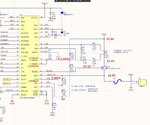ben5243
Member level 3

Keep checking between old and new boards - read the data sheet and the app notes carefully ...!
- - - Updated - - -
Two things from the data sheet: 1) if a PowerPath FET is not being used, such as with a lead-acid charging application, connect a 0.1nF capacitor from BGATE to CSN.
2) If the battery voltage is lower than the instant-on threshold (see VFBMIN), BGATE servos the PowerPath FET imped-ance such that a voltage drop between the CSN pin and the BAT pin is created while battery charging continues. If the VCSN – VBAT voltage exceeds 0.4V, maximum charge current is reduced to decrease power dissipation in the PowerPath FET. so at 10A and 0.38V the diss can be 3.8W - enough to kill a fet not heatsunk enough ...
The battery voltage is higher than the instant-on threshold so it's either operating incorrectly or something else is the problem.
(oops my picture did not attach properly in my last post, here it is)

VFBmin is 24.7V
Battery voltage is 26.9V.
I just let it run and battery has charged up to 29.035V now (Vfloat is 29.063V)
Charge current is starting to taper off so it's operating in CV mode now and the powerpath FET is still hot enough to burn me. As current decreases, it is getting cooler, but the gate is still not pulled down. I don't think the chip is in instant-on mode, something else must be wrong. My only idea is to try more new P-FETs, I have more coming tomorrow but I don't think it will help. The FET I am using right now was pulled from my old board which worked fine.



